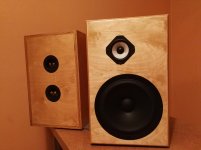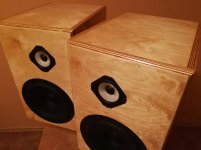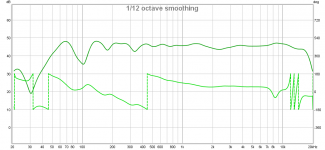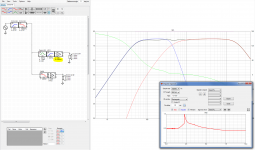The easy part is officially over, now all that's left is hundreds of measurements, xo adjustments and constant questioning of everything
I do love the look of varnished birch...
very nice build


I have used 16ga stranded copper, but did find improved bass dynamics when switched to stranded 12ga. The measured amp DF went up when using 12ga vs 16ga as well. There is a really nice supple premade cable with banana jacks that was reasonably priced. Priced each.
Amazon.com: Mediabridge 12AWG Ultra Series Speaker Cable - Gold Plated Banana Tips (6 FT) - CL2 99.9% Oxygen Free - Black (SWT-12B-06B): Electronics
Amazon.com: Mediabridge 12AWG Ultra Series Speaker Cable - Gold Plated Banana Tips (6 FT) - CL2 99.9% Oxygen Free - Black (SWT-12B-06B): Electronics
I tried solid copper Romex 12ga house mains wiring for my amp to speaker and measured a definite increase in damping factor and could hear better bass authority. However, it is a pain to use as it is not flexible. This is an area of hot debate and voodoo as there are $100k speaker cables out there. What is important is low intrinsic impedance, so large wire - stranded is fine as long as copper and good quality. Silver and teflon probably not important for speaker cables.
Yes, for cables physics trumps voodoo. Audio frequencies aren't high enough to have significant skin effect. If you want to get resistance down, just use lots of copper - silver is only 7% more conductive but about 100 times more expensive than copper. Look at NASA and CERN: all cabling is based on sound physical principles - they would never spec voodoo silver-plated copper with PTFE insulation for audio frequencies in a non-hostile environment at room temperature and presssue.
Some time ago, we had quite an expensive audio system put into one of the operating theatres at the hospital I was at. The techs phoned up the manufacturer (maybe Quad) to ask about cabling. They said to use 'cooker cable' - 6mm2 copper, just a bit over 10 A.W.G.
Some time ago, we had quite an expensive audio system put into one of the operating theatres at the hospital I was at. The techs phoned up the manufacturer (maybe Quad) to ask about cabling. They said to use 'cooker cable' - 6mm2 copper, just a bit over 10 A.W.G.
X, did you post the details anyplace?
Seems that the speaker's impedance would dwarf any cable effects, especially on such a short run.
Speaker cables don't influence harmonic distortion!
On a Class A amp, I got a change from DF of 5 to 30 by switching from 16ga stranded to 12ga solid core Romex. For a SS CLass AB amp with DF in the 400 range, this could be even more of a significant factor.
The speaker itself may have impedance of 8ohms to maybe 40ohms, but you don't want any impedance in the cable delivering current to the actual load location.
I just made a 3 meter twisted pair of Teflon coated silver coated copper using a combination of 13 awg and 16 awg wires . They sounded excellent dynamics improved , bass didn't seem to change but the highs just much more clarity and detail . To me they sounded fast , I know that's insane call the men with the white coats stuff but they do.
Thanks for the link.Speaker cables don't influence harmonic distortion!
On a Class A amp, I got a change from DF of 5 to 30 by switching from 16ga stranded to 12ga solid core Romex.
Assuming those DFs are relative to an 8-ohm load, the 16awg added > 1.2 ohms, right? This seems a bit high for 5-6'. Any chance you had a bad wire or connection?
Either way, I'm not surprised you could hear a difference with those results!
Agreed. Absolutely.The speaker itself may have impedance of 8ohms to maybe 40ohms, but you don't want any impedance in the cable delivering current to the actual load location.
Both cables used the same type of gold plated banana plugs soldered directly to the wire. This is with 1kHz excitation and I can see how it’s hard to explain why a circa 2m 16ga cable can have over 1ohm impedance. I wonder if there is some effect of how one is solid vs other is stranded. Or perhaps 16ga stranded exaggerated its gauge?
I would like to thank xrk971 once again for sharing this design concept and helping everyone who tries to replicate his FAST system.
I am very very happy with these speakers, mainly due to very low distortion and clarity. So far I've settled on LR12 at 400Hz. LR12 at 300Hz sounded very clear but somewhat strained, 500Hz muffled (I suppose I don't like SB23's mids), LR24 muted at any frequency and I couldn't get a proper Harsch in several hours so put that aside for the future.
Also noticed that my TG9FDs have a shelving droop of about 2dB from 2kHz and the SB23s have a rising midrange, so solved both of those with a global eq (Q 0.5, -2.5dB, fc 1kHz). Result attached, measured at ~1m, gated at 6 cycles.
This is the nice thing about active - I can try a dozen different configurations in an afternoon and the difference is massive!
I am very very happy with these speakers, mainly due to very low distortion and clarity. So far I've settled on LR12 at 400Hz. LR12 at 300Hz sounded very clear but somewhat strained, 500Hz muffled (I suppose I don't like SB23's mids), LR24 muted at any frequency and I couldn't get a proper Harsch in several hours so put that aside for the future.
Also noticed that my TG9FDs have a shelving droop of about 2dB from 2kHz and the SB23s have a rising midrange, so solved both of those with a global eq (Q 0.5, -2.5dB, fc 1kHz). Result attached, measured at ~1m, gated at 6 cycles.
This is the nice thing about active - I can try a dozen different configurations in an afternoon and the difference is massive!
Attachments
Nice work Wxn! I am glad you like the result. I have had these as my main speakers for over 2 years now and have tried many but keep coming back to them. The overall balance and ability to play many different genres well while being relaxed and engaging is their strength. They are not the loudest speakers, not the speakers with high end zing, but balance is the key.
So are you using a Harsch Xo? The woofer needs to have a Bw4 lowpass snd mid tweet a Bessel 2 (all acoustic) so electrically might be any number of different filters. If you get a chance, please post the XO plots and step response. But most importantly, is that you like the sound whatever the XO may be. The Harsch XO gives the best presentation of percussion like guitar piano bass and drums.
So are you using a Harsch Xo? The woofer needs to have a Bw4 lowpass snd mid tweet a Bessel 2 (all acoustic) so electrically might be any number of different filters. If you get a chance, please post the XO plots and step response. But most importantly, is that you like the sound whatever the XO may be. The Harsch XO gives the best presentation of percussion like guitar piano bass and drums.
Last edited:
For Harsch at 400Hz remember delay acoustic center for midtweeter relative to woofer 1/400=1.25mS, that said real world the two acousitc centers are not alligned so probably a little less. Also not shure if one can select a Bessel textbook filter into DSP engine at 400Hz, at least into VirtuixCAD the build in Bessel textbook filter would not work and have too muck overlap, it begins to work using 450-500Hz numbers. Alternative that works perfect is form a Bessel slope at 400Hz for Harsch is use 2nd order LR at 400Hz plus a PEQ at 400Hz +1,3dB/Q0,58, as seen below.
Attachments
Last edited:
- Home
- Loudspeakers
- Full Range
- 10F/8424 & RS225-8 FAST / WAW Ref Monitor



